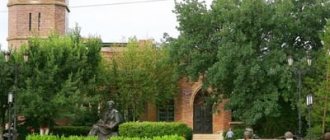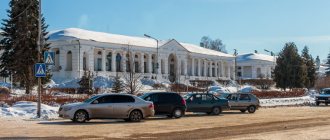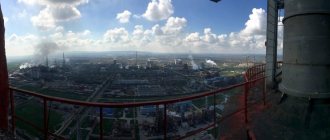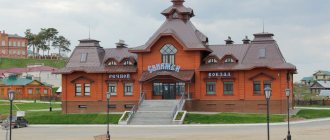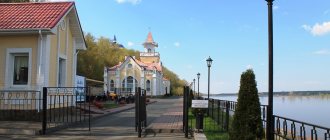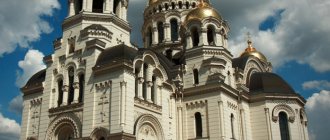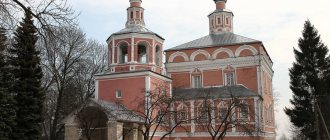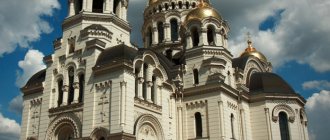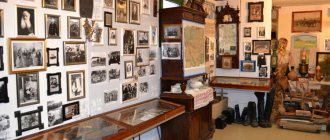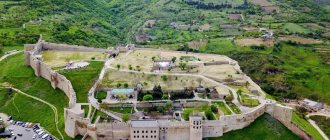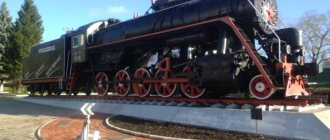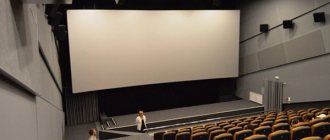What is the winteriest city in the Chelyabinsk region? Of course, my beloved Kyshtym. After all, even the name translates as “quiet winter hut.”
It’s truly quiet and peaceful here. And very interesting. The town is ancient. It was formed in the 18th century in connection with the construction of a factory. More precisely, there were two factories here: the Verkhne-Kyshtym iron foundry and the Nizhne-Kyshtym ironworks .
Church of the Descent of the Holy Spirit
This two-story church is the oldest stone building in Kyshtym. The top floor is dedicated to the “heavenly” - namely, the descent of the Holy Spirit on the apostles. The lower one was named in honor of the earthly prophet, awarded the highest mysteries - John the Baptist. The church was erected in 1760-1764. on an island in the middle of a city pond, which is quite reasonable in case of fire.
The Pugachev rebellion of 1774 turned the temple into an amateur hotel for dashing guys: they camped around the church, burned fires in it and led their horses into it.
After the defeat of the rebellion, church property was found for a long time in the surrounding villages and returned to its place. Of course, the temple had to be consecrated anew - so that already in 1936 the spiritual heirs of the Pugachevites would again be thrown from the bell tower - fortunately, with bells, no longer by people. The Bolsheviks turned out to be more durable and economical than the “scarecrows” and adapted a good building either for storage or for film distribution. Now the church is being restored.
Location: Sadovaya street - 9.
Sights of Kyshtym
Since the city began with two factories, it is still divided into Upper Kyshtym and Lower Kyshtym. The most interesting is Upper, especially its historical center.
The main attraction of the city of Kyshtym and its calling card is the so-called White House - the estate of the factory owner (Karl Marx St., 2). The high importance of the White House for the city is clearly evidenced by the fact that it appears on its coat of arms (along with the Sugomak and Egoza mountains).
Construction of the estate began by Demidov along with the construction of the Verkhne-Kyshtym ironworks in the 1750s. The architect is unknown, but there is an assumption that the author of the project was the famous architect Matvey Kazakov. At first it was a two-story manor in the Baroque style.
In the first half of the 19th century, by order of the new owner, L.I. Rastorguev, the building was reconstructed according to the design of the talented Yekaterinburg architect M.P. Malakhova. Reconstruction was completed already under G.F. Zotov. After this, the external appearance of the building began to resemble the Rastorguev-Kharitonov estate in Yekaterinburg.
The building in the classicist style has three floors, decorated with large columns, reminiscent of a palace. They called him White for his whitewash. It housed the Main Directorate of the Kyshtym Mining District. The factory owner stayed here during his visits, the families of managers, government officials, the chief forester, and servants lived here. Famous people who visited the Kyshtym factories also visited here. Among them was the famous chemist D.I. Mendeleev in 1899.
During Soviet times, the White House was occupied by a vocational school, a nursing school, and a pedagogical institute named after Leningrad, evacuated from Leningrad. Herzen, the House of Pioneers, a children's library, and later it was transferred to the local history museum.
The White House is a federal cultural heritage site. In 2000, renovation and restoration work on the White House began. They walk extremely slowly, the condition of the building is still very sad. We can only hope that someday the restoration, which has lasted for several decades, will end, and the building will again become the pride of the city and will delight people.
For the period of restoration, the Kyshtym Historical and Revolutionary Museum is located at st. Metallurgov, 2 (tel. (35151) 4-12-55). By the way, the museum in the White House arose at the end of the 19th century, when the manager of the Kyshtym mountain district P.M. Karpinsky collected a collection of artistic castings and mineral samples here. After the revolution, part of the casting was exported abroad, and after the fire of 1921, the rest was transferred to the Sverdlovsk Museum of Local Lore. In the 1970s, the museum was created virtually anew, on a voluntary basis.
In addition to the main house, the architectural ensemble of the factory owner's estate also includes two outbuildings with towers, a park, and a fence with a gate. Particularly interesting are the outbuildings , above which rise massive octagonal watchtowers with high hipped roofs. In one of the wings there was a factory office, and in the other there was a stable. Resembling formidable fortress towers, they were quite suitable for defense if necessary. They were topped with spiers, which previously had metal weather vanes depicting camels - symbols of trade. The towers are now abandoned. Researcher V.I. In 2003, Yurin found marks from Demidov factories on iron connections in the attic of the northern watchtower.
underground passages leading from the towers . We once got into one of them. This passage connected two outbuildings, its length is about 70 m. It was built in an open way in the form of a trench. The walls are made of wild stone and widen slightly at the top. In Soviet times, the passage was adapted for communications, and pipes were laid here. Surely similar moves were made towards the White House. Somewhere here there was a prison and a torture chamber, in which, according to legend, Grigory Zotov dealt with people. There are also underground passages on the territory of the plant.
In front of the White House there is a monument to M.I. Kalinin . The location is no coincidence: in 1921, the All-Union headman spoke to the Kyshtym residents from the balcony of the White House. The monument was erected in 1959, the author is sculptor L. Pisarevsky.
Nearby, in the same park near the White House, there was an old cast-iron fountain . It was cast by Kasli craftsmen and installed back in 1857 on Prezavodskaya Square (dates 1856 and 1846 are also found). The fountain was unique. It worked without any pumps - using natural water drops. Through pipes laid along the bottom of the Kyshtymka River, water flowed into the fountain from the city pond.
This was a real curiosity of Kyshtym, which, like a miracle, residents of the entire district tried to gaze at. The fountain consisted of four bowls of different diameters, located horizontally. Water flowed from bowl to bowl. Local residents not only admired the fountain, but also collected water here.
In the 1970s, during the reconstruction of the square, the fountain was moved to the park near the White House. For some time, water was pumped into it, but then it was turned off. The fountain was recently dismantled for restoration, which was promised to be completed in 2022.
Next to the White House estate is the territory of the former Verkhne-Kyshtym plant, now the Kyshtym Machine-Building Association (2 Kooperativnaya St.). From the buildings of past centuries, part of the blast furnace shop, the mechanical shop building, administrative buildings overlooking the square, and part of the factory fence made of artistic casting have been preserved.
Verkhne-Kyshtym reservoir (City Pond) overflowed . A rather complex hydraulic system has been created here, connecting a chain of lakes and ponds with canals and channels. Only on the Kyshtym River itself the complex of hydraulic structures includes the Novo-Kyshtymskoye (Kyshtymskoye) reservoir, Dekhanovsky pond, Verkhne-Kyshtymskoye and Nizhne-Kyshtymskoye reservoirs.
The main thing in this system was the Verkhne-Kyshtym pond. Numerous bays, capes, and islands formed here. The preserved drainage arched tunnel, about 100 m long, is also very interesting, but it is located on the territory of the plant. In some places the banks are reinforced with old granite blocks. They say that along the so-called “Demidov ditches” it was previously possible to sail by boat in one direction to Lake Uvildy, and in the other to the Kasli lakes. It is not surprising that Kyshtym is sometimes called the Ural Venice .
In 2022, as part of the 6th Ural Industrial Biennale, artist Ivan Gorshkov created an art object “Tease” . In Kyshtym, a teaser was an outdated tool for metallurgical production, which was a wooden log. According to the author, the object reveals the history of the city, industry, human and natural elements of the region, which are fused into a single image that pays tribute to the traditions, history and memory of these places.
On an island in the middle of a pond near the White House stands the ancient stone Church of the Descent of the Holy Spirit on the Apostles (Sadovaya St., 23). Other names: Old Church, Spiritual Church, Church on the Island. It was built at the expense of N.N. Demidov and parishioners since 1760, consecrated in 1765. According to legend, it was built at the site where Demidov stopped for lunch, as the memorial stone reminds. Of the stone churches in the Chelyabinsk region, only one is older - in the city of Troitsk. During the Pugachev riot, the church was looted. Until the mid-19th century, it was the main temple of the Kyshtym mountain district. The church was closed in the 1930s and is now being used again by the Russian Orthodox Church. It has been preserved almost in its original form, without modifications.
Approximately opposite, on the same island, is the estate of G.V. Druzhinina (Sadovaya St., 2). Grigory Druzhinin married Kharitonov’s daughter and became the actual owner of the Kyshtym factories. Built in 1850-51, the two-story wooden house is decorated with decorative architraves. There was a warm greenhouse adjacent to it. There was a deep basement with a separate entrance and a brick doorway. There were rumors that there was an underground passage to the White House from there, although there was an ordinary glacier for storing food. In Soviet times, the building was occupied by the executive committee, a music school, then an art school, and now the Station for children and youth tourism and excursions “Strannik”.
On the other side of the pond, the two-story building of the Kyshtym Factory Hospital (1 Osvobozhdeniye Urala St.), built according to the design of the architect A.P., Chebotarev in the style of classicism. It was built from 1830 to 1846. The front façade is decorated with columns. The building is still used for its intended purpose - it is a hospital. In 1991, director Vladimir Makeranets filmed the film “The Governor” here; in the plot, the hospital building in the film depicted the governor’s house.
To the north of the hospital, on the shore of the pond, there is a very beautiful building of the People's House (Teatralnaya St., 2). It was built in 1913, the architect is unknown. The building was recently restored. At the same time, they landscaped the embankment here, installed lanterns made of Kasli casting and benches.
But let's go in a different direction. Near the White House estate there is a transport ring, from which Lenin Street begins. On it stands the Cathedral of the Nativity of Christ (Lenin St., 22). A stone 2-story temple was built on the highest point of the city at that time in 1848-57 for the 100th anniversary of the plant. Built in the Russian-Byzantine style. The church was closed in 1935, but was reopened in 1941.
Next to the church there is a monument to firefighters in the form of a fire truck on a pedestal. It was opened in 2012.
A little further along Lenin Street there is Victory Square (in front of the Pobeda Palace of Culture). For the New Year, a winter town with a Christmas tree and a slide is being built here. In 1985, a monument to home front workers (other names are “Worker” or “Ural Forged Victory”). A worker stands on a pedestal; in his raised hand he holds a hammer, and with his other hand he presses a sword wrapped in a guards ribbon to the ground. Authors: sculptor M.I. Kharlamov and architect V.P. Chertovikov.
Continuing along Lenin, you can go to the old cemetery . Here, in two mass graves, soldiers who died of wounds in hospitals during the Great Patriotic War were buried. Monuments were erected in memory of this. In the same cemetery there is preserved the grave of Pavel Mikhailovich Karpinsky , a talented mining engineer, with whose name one of the ascents of the Kyshtym mountain district at the turn of the 19th-20th centuries is associated.
of the Kyshtym Women's Gymnasium (Respubliki St., 10) is also interesting This is a beautiful two-story building made of red brick, with large arched windows, built according to the design of technician I. Ushakov in 1907. The women's gymnasium in Kyshtym was the first and only one in this mining district. After the revolution, a nine-year school was opened in the building, and during the Great Patriotic War the Pedagogical Institute named after A.I., evacuated from Leningrad, was located. Herzen. Later the building was occupied by a technical school.
Not far from here, on the shore of the pond, stands the former Edinoverie Holy Trinity Church (Krasnoarmeyskaya St., 1), built at the expense of the merchant and manager of the Upper Kyshtym plant T.P. Zotov in a record short time - in 1847-49. The author of the project was the architect Konstantin Ton. During Soviet times, the church was closed, the bells were removed, and the dome drums were destroyed. The building housed a mechanical plant club and a cinema attached to it, and later a factory museum was organized here. Then the building stood abandoned. It has now been transferred to the Russian Orthodox Church and is being restored. While clearing the basements, volunteers discovered human bones lying without coffins in small well pits. Who it is and how they ended up here is unknown.
Nizhny Kyshtym microdistrict is located to the side . It is much smaller in size compared to Verkhny Kyshtym. The path to it passes by the railway station. Among its attractions it is worth noting the following: the Church in the Name of St. Nicholas the Wonderworker, built in 1896 (Chernyshevsky St., 1), the Metallurg Palace of Culture (Internatsionala St., 103), the embankment of the Nizhne-Kyshtymsky pond with the motor ship "Raketa-248" and a small open-air air defense museum
Also in the architecture of Kyshtym, the following interesting objects of the 19th century can be noted: the volost government (Nekrasova St., 2), the house of factory employees (Sovetskaya St., 9), a residential building (Sovetskaya St., 37), a two-story brick building (Lenin St. , 20).
On the southwestern outskirts of the city is the Dalnyaya Dacha sanatorium . A pond was created here on the Kyshtymka River, named in honor of L.N. Dekhanov - the founder of Dalnaya Dacha, manager of the Kyshtym factories. Here they built a two-story stone house with rich stucco (a smaller copy of the White House), laid out a garden, installed a fountain, planted larches, and installed statues and flower beds along the paths. During Soviet times, in 1933, a sanatorium was opened here.
There was also a so-called Blizhnaya Dacha , founded by factory owners in the mid-19th century for recreation and receiving guests and summer holidays for factory employees. A park was laid out here and a greenhouse was built. The gardener was Efim Khodov, who distinguished himself in the arrangement of Kharitonovsky Park in Yekaterinburg. In 1899, the Near Dacha was shown to the scientist D.I. Mendeleev.
Cathedral of the Nativity
It is visible from literally everywhere in Kyshtym, as it was deliberately built on the highest point of the landscape - a two-story, majestic, probably the most popular temple among local Orthodox Christians. It has five domes, two upper and two lower aisles. The style is characterized as “pseudo-Russian” or “Russian-Byzantine”.
Construction began by serf workers in 1848 and lasted nine years. But even in 1857, the temple could not yet be called complete, but services in it had already begun. The inside of the temple was painted - until 1902 - by the artist Y. Epanechnikov. In the mid-1930s, the temple was closed, but in 1941 services began to be held there again.
Location: Lenin street - 22.
Ural Bali
Again wondering where to go and see something, we remembered that there are still so many interesting places near Kyshtym. No sooner said than done!
Coaline quarry or as the guides temptingly call it “Ural Bali”
More recently, kaolin was mined here, a type of white clay. At the moment, work has stopped and the quarry has filled with water. It is thanks to kaolin that the bottom and banks of the quarry are white and the water is azure-turquoise. There are rumors that in the near future development will be resumed and water will be pumped out from the quarry. Honestly, I wasn't impressed by this place, "Beautiful advertisement on a brick wall." Of course, you can bother for the sake of a spectacular photo, but this is definitely not for me. The only thing that really shocked me about this place was the fox who fearlessly approaches people and begs for treats.
Well, okay, let's move on.
Nicholas Factory Church
It was built on the site of a small chapel in the village of the Nizhne-Kyshtym plant, since the population in the village had increased, and the chapel could no longer accommodate all the believers. Funds for construction were allocated by the owners of the land - the Rastorguev factory owners, and donations from parishioners were also collected.
The solid stone church took four whole years to build, and was consecrated in 1896 in the name of the people’s most beloved saint, St. Nicholas the Wonderworker.
In the 1930s, the authorities decided to close the church. In 1944, there was a weak attempt to revive the church and hold services, but the disfigured building without domes never turned into the former temple and was abandoned.
Restoration began only in 1993, and in 2005 the church returned to the believers. By 2007, the church was completely restored.
Location: Chernyshevsky street - 1.
History of Kyshtym
This settlement arose as a mining settlement at the Upper and Lower Kyshtym ironworks on the Kyshtymka River, founded by Nikita Nikitich Demidov on lands purchased from the Bashkirs. The founding date is considered to be 1757 , when the first products were received.
It is believed that the name came from Bashkir words meaning “winter camp” or “quiet winter hut” . According to another version, peoples who paid tribute to another people were called Kyshtyms in Tatar (this was pointed out by the historian G.F. Miller in the 18th century). Kyshtym residents adhere to the first option.
During the Peasant War in 1774, the Kyshtym factories were captured by Pugachev’s associates, burned and looted. Later the factories were restored.
In 1809 P.G. Demidov sold the Kyshtym factories to the Yekaterinburg merchant L.I. Rastorguev . In 1822-23, the largest workers' uprising in the 19th century took place in the Kyshtym mountain district, caused by deteriorating living conditions, non-payment of wages and food shortages.
The city of Kyshtym from Mount Sugomak. Photo by Nadezhda Shimalina
Since 1823, the factories were managed by Grigory Zotov the “Kyshtym Beast” for his cruelty . Rumors about Zotov’s arbitrariness reached St. Petersburg. They were investigated by Count A.G. Stroganov. As a result, G.F. Zotova and P.Ya. Kharitonov was put on trial. The proceedings went on for ten years. In 1837, they were exiled for life to the Finnish city of Köksholm. The further fate of Zotov and Kharitonov is unknown. Now they are increasingly talking about Zotov as a talented manager, forgetting what human sacrifices this was achieved...
Kyshtym belonged to the Yekaterinburg district of the Perm province. In the first half of the 19th century, it became the center of the Kyshtym mountain district , which, in addition to the Kyshtym factories, included the Kaslinsky, Nyazepetrovsky, Shemakha and Techensky plants, as well as mines and gold mines.
In 1896, a railway , connecting Yekaterinburg and Chelyabinsk. Before this, the metal was sent by water in barges from the Nyazepetrovskaya and Sorokinskaya piers on the Ufa River.
In 1900, the mining district was corporatized. In 1907, the Kyshtym Mining Plants Society was taken over by the Englishman Leslie Urquhart . His deputy was Herbert Hoover , the future 31st President of the United States.
During the Civil War in July 1919, there were battles here, as a result of which the Kyshtym factories were liberated from the Whites by units of the Red 35th Infantry Division.
In May 1921, a terrible fire broke out in Kyshtym, destroying about a third of the city - about 700 houses burned down. The chairman of the Central Election Commission himself, the “all-union headman” M.I., Kalinin , who specially came to Kyshtym.
Kyshtym received city status in 1934. The main industrial enterprises: copper-electrolyte, abrasive, refractory, electromechanical plants, machine-building association, radio plant, kaolin plant, Russian Quartz, knitwear factory and others.
At the beginning of the 20th century, the Kyshtym Copper Electrolyte Plant began producing refined copper . Later, in 1928, the first batch of Soviet selenium , and in 1932, tellurium . By the way, Kyshtym selenium was also used to make ruby glass for the new stars of the Moscow Kremlin . Originally in 1935 they were made of high-alloy steel and red copper with precious Ural gems, but a year later the stars faded. Then, in 1937, they were replaced by new luminous ruby stars, and Kyshtym selenium gave them a rich bright red color. And at another enterprise, the Kyshtym Mechanical Plant, in 1934, among other things, they began production of the first domestic rotary hammers .
In the mid-20th century, as part of the Atomic Project, the Mayak plant and the closed city of Ozyorsk were built nearby. On September 29, 1957, a serious radiation accident occurred there. An explosion occurred at a liquid waste storage facility, causing a radioactive cloud to rise into the air and cover a large area. An extensive East Ural radioactive trace (EURT) was formed, and many villages had to be relocated after this. The radiation disaster was kept secret, officially confirmed only in 1989. According to the nearest “open” city, it was called the Kyshtym accident , although Kyshtym has nothing to do with it.
The Kyshtymite rock is named after the city . The population of Kyshtym is 36 thousand people.
The Demidov-Rastorguev estate
Locals call it the “White House” for its snow-white facades. This is the family nest of the founder of Kyshtym, Nikita Demidov, built by him in 1757, together with the Upper-Kyshtym and Nizhne-Kyshtym factories. Demidov was a solid man and built himself a real estate with a large house, two outbuildings with turrets, a garden and a park.
Druzhinin's House
This grandiose structure is something like a wedding gift from Grigory Druzhinin to his young wife Olga, who came from the Rastorguev family of breeders. The mother-in-law, Maria Lvovna, needed a man’s hand to manage the factories and persuaded her son-in-law, a colonel of the Life Guards of the Moscow Regiment, to appear in Kyshtym more often. So he marked his presence with the construction of this estate in 1850-1851, and then received a power of attorney from his mother-in-law for the “unaccountable” management of the factories.
Stone gate
This mysterious rock has several names: Dragon Wings, Dragon, Devil's Gate, Stone Gate. And how many different legends and fables have been invented about this stone remnant. But until now we have only seen it in photographs, it’s a mess, we urgently need to correct the situation. There is a lot of information on how to get to the “Stone Gate”, but for us, “not tourists”, all of it turned out to be absolutely useless. Having finally quarreled with all the navigators, we decided to act as usual, “let’s go over there and we’ll figure it out there.”
Approximately a couple of kilometers from the village of Slyudorudnik, the lady from the navigator (the only one who survived the massacre) yells, “Turn right!” Either from surprise or from fear, the husband turned off the asphalt road into the forest. Surprisingly, there was quite a decent road here. But we still decided to stop and look around, there’s a forest on the right, a forest on the left, ahead is a road into the unknown, just as we like. Oh, it was, it wasn’t, if we come back.
In general, we finally found this enchanted place. By the way, the road is relatively flat only for the first kilometer, as soon as you see a small clearing where cars and minibuses are parked, that’s it, then only by all-terrain vehicle or on foot.
We, the “mad ones”, drove up as close as possible, and then walked up the hill, along the path that goes to the left, and here it is a magical rock with many names.
Since there was a queue of people at the rock wanting to take pictures of themselves in different poses against the backdrop of the miracle stone, we decided to take a walk nearby. This place is really quite interesting, and even unusual.
But most of all I was surprised and even a little frightened by the memorial plaques installed a little to the side of the “Stone Gate”.
An unpleasant chill ran down my spine. They began to look around and move more carefully, you never know. It was only later that we learned that these people ended their earthly journey far from these places. And the memorial signs were installed by local activists from the Ural-Kosmopoisk association. We returned back in the hope that people had already “taken selfies” and we would still be able to take a photo of the rock from different angles. Yeah, we're daydreaming! The photo shoots continued, we already wanted to give up and go back to the car, fortunately there were already plenty of impressions. But, nevertheless, I managed to catch a small gap (while the fashion models were changing their image). I quickly, like a squirrel, climbed up the stones, and also tried to pretend to be a “dream woman.” And quickly back down before they beat you. True, the photos didn’t turn out very well, well, at least it was something rather than nothing at all.
In general, we liked this place, there really is something to see and be surprised by.
Shigir ghost
This is the nickname of the Azyash-Ufa plant, which the cunning Demidov hid in the forest so as not to pay taxes. But less than 15 years later, the invisible plant really turned into a ghost - it was completely destroyed by the Bashkirs during the Pugachev rebellion. The ruins of the plant can be seen at the Malaya Shigirskaya Sopka, near the Dolgobrod Reservoir.
Women's gymnasium
A strict, but at the same time elegant red-brick structure appeared in Kyshtym in 1907. It was intended as a gymnasium for girls. The program was usual for women's gymnasiums - it included lessons in music and dance, home economics and handicrafts.
In the first intake there were 138 “not ordinary” girls. This building was historically very lucky - even when the bones of the very first students decayed, the former gymnasium remained an educational institution. Now the building belongs to the technical lyceum.
Location: Republic Street - 10D.
Hospital
We will cross the bridge to the other side of the pond. Immediately in front of us is the Hospital .
The building was built as a hospital. It turned out beautiful. The breeders thought that it would be a pity to give such a good house to a hospital. And they set up a gambling house in it for the entertainment of the gentlemen - fun, dancing, cards, roulette. In 1860, the first floor was a hospital inpatient unit, and the second floor was used to receive and entertain visiting guests.
In 1991, the film “The Governor” about the first Russian revolution was filmed here. The role of the governor's house was played by the Kyshtym hospital. And the Kyshtym residents themselves performed in the crowd scenes. On this occasion, they found things from the early twentieth century in their grandmother’s chests.
Monument to the liquidators of the Kyshtym-57 accident
In 1957, the first radiation disaster in the USSR occurred at the Mayak chemical plant in a closed city near Kyshtym: a container for radioactive waste exploded. Ozersk (then called Chelyabinsk-40) was classified beyond recognition - the radioactive glow in the atmosphere was passed off by the media as the aurora, and the monument to the liquidators of the accident was erected not at the site of the accident, but in Kyshtym. However, the monument cannot be called a fake - about 200 local residents actually participated in the liquidation of the accident and the removal of contaminated soil.
Location: Lenin street - 50.
Kyshtym dwarf
In 1996, local pensioner Tamara Prosvirina discovered a strange small creature in the forest under a pine tree (according to another version - in a cemetery). She took him to her home, named him Alyoshenka and fed him mainly sweets. Soon the woman was forcibly taken for treatment to a psychiatric hospital, and at that time Alyoshenka died, left all alone in the old woman’s apartment...
This is the story of the “Kyshtym humanoid”. Subsequently, the body of the unknown creature disappeared without a trace, leaving only photographs and video footage. The story gained quite a lot of publicity. Journalists from Japan even came to Kyshtym, who subsequently released the film “In the Footsteps of the Alien Alyoshenka.”
Some experts consider the Kyshtym dwarf to be a successful hoax, others - a consequence of a mutation, and still others attribute to it a cosmic origin. Skeptics claim that this is nothing more than an urban legend. In 2015, in the vicinity of the city, on the shore of Lake Anbash, a life-size monument to “Alyoshenka” was erected. It enjoys considerable popularity both among tourists and local newlyweds. Both leave candy at the feet of the sculpture.
Sugomak cave
The only cave with marble in the Urals. The length of the cave is 123 meters , in the first of the three grottoes the ice never melts, in the second in winter the “chambers of the Snow Queen” are formed, decorated with frosty patterns and ice crystals. And the third grotto is difficult to access - it is something like a narrow well, where those who wish can descend on a rope. At the entrance to the cave, someone very patient knocked out the profile of the leader of the world proletariat in the rock, but did not explain why.
Sugomak
One summer, my family (husband, daughter and future son-in-law) decided to relax in nature. I was unanimously appointed as the organizer of this event. A couple of days before departure, I made my family happy by introducing them to the plan for the weekend tour. And so, we’re going to Sugomak, first we’ll look around the cave, then we’ll climb the mountain, and at the end we’ll go to the lake, barbecue, swim, sunbathe and go home. It was only later that I found out that everyone heard only three words (barbecue, lake, home). For us, “city dwellers,” every trip to nature is like a flight into space. Therefore, for a comfortable stay, we took everything with us except a refrigerator and a TV. Well, that's it, let's go on vacation!
Who would have known then that this trip would become an epoch-making event for our family.
In high spirits, despite the fact that rain clouds accompanied us all the way, we simply flew to the city of Kyshtym. And then along Lake Sugomak, which everyone looked at with lust, anticipating a long-awaited vacation, we headed to the Sugomak Cave.
And here we are at a small area where we could leave the car. After a long life in the “concrete jungle”, literally everything in nature surprises and delights, every blade of grass, insect, pebble. To begin with, we walked along Maryina Polyana and examined the spring of Maryina's tears.
And then we went to the Sugomak cave
It turned out that the children were already here, when they were still in school, they were taken to these places on an excursion. I remembered how my daughter told me about this trip - “Mom, it was a nightmare, I won’t go anywhere else”!And the son-in-law remembered that somewhere over there (he pointed his finger somewhere down under the stones) there was a hole into the second hall of the cave, but last time he couldn’t get there. I didn’t even have time to blink before he darted down under the stones, trying to crawl into the narrow hole. “Stop!” I yelled in a voice that wasn’t my own, “You’ll get stuck!”
My son-in-law froze as if he had hit the stones and looked at me in fear.
My husband, who did not climb into the cave, but stood at the entrance, shouted, “Let him climb, we’ll get more meat.”
With persuasion and threats, we pulled our son-in-law out of the cave and moved on.
And ahead of us was the climb to Mount Sugomak. This is where we all learned what a sedentary lifestyle leads to. To say that this climb was difficult for us is an understatement. But damn me, it was worth it!
No photographs, videos or even stories can convey all the splendor and spaciousness that appeared before us. It was then, on this day, standing on the top of Mount Sugomak, that I realized that my life would never be the same again!Mount Egoza
The highest mountain in the vicinity of Kyshtym. No, she doesn't move like Howl's Moving Castle. And its name is actually not “egoza” - it’s the Russified Bashkir “Egauyzy” - the entrance to the intermountain region. The mountain is indeed located near a river, marking the entrance to the mountain range. Relict plants are found on Mount Egoza. Now there is a ski resort there.
How to get there
The most convenient way to get here is by bus:
- from Yekaterinburg buses run every day, the journey takes 3.5 hours, ticket price starts from 350 RUB;
- There are many bus routes departing from Chelyabinsk every day, travel time is about 2 hours, tickets from 260 RUB;
- There are many buses from Miass every day, travel time is 1.5-2 hours, tickets from 200 RUB. Prices on the page are for February 2021.
By car from the nearest major cities:
- from Chelyabinsk the journey takes from 1.5 to 2 hours (depending on the route 101-110 km),
- from Yekaterinburg you need to drive along the M5 highway for 2.5 hours (150 km),
- from Miass we head along the Miass - Karabash highway for 1.5 hours (90 km).
Trains heading to Tyumen, Baku, St. Petersburg, Astana, Novy Urengoy, and Chelyabinsk also pass through the Kyshtym station.
Search for cheap flights to Kyshtym
